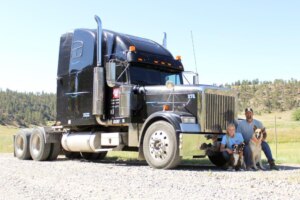Mike Wilson & Lisa Rush
"Anytime there's a regulation it’s going to create a cost and it has to be either absorbed or passed on."
“I went to work for Whitewood Transport in 1991, in Billings. And over a period of time I was able to buy out the existing partnership group and in 2012 I took it over solely and have been here at the helm ever since.”
“We primarily use trucks to move oversized equipment for the construction, mining, forestry, agriculture and energy industries.”
“As manufacturing has ticked back up, factory output is up, there is a greater demand for what we’re doing. We absolutely exhausted all of our inventories in 2020 because globally manufacturing was at a standstill and now we’re trying to make up for that which has created such a huge demand for trucking.”
“There are a number of regulations that we have to adhere to. Most of the regulations that we fall under are mandated by the Federal Motor Carrier services, but some fall under Montana law.”
“The permitting process to move things across different states can be pretty extensive. For example, the typical semi is legal at 80,000 pounds that includes the weight of the truck, the tractor, and the freight. If it’s a single piece of freight, let’s say a bulldozer, and it weighs 85,000 pounds then it obviously puts you over the 80,000 limit. You then have to go online, fill out the application for the permit which then goes to the Montana Department Transportation, they issue the permit, and if approved we can move the load. It can be interesting because every state has a different process for that. So for moving a CAT dozer out of Montana to Chicago, Illinois, we have to do something different in every state.”
“We’ve also had to install these electronic logging devices [ELD] in all the trucks and there is a pretty huge cost to doing that. Someone has to pay it, and it’s not necessarily something you can charge back to a customer. ELD’s are really a gray area because they protect the carrier by establishing accountability for hours of service but the problem that the ELD mandate creates is if you’ve got a guy that is tying down his load, for example, he might normally throw an extra chain or strap over his load. He’s got time, he can do it – but now he’s under so much pressure to properly manage his time, maybe he doesn’t put that extra chain or strap on. Not that he necessarily has to, but he does it to be extra extra safe.”
“Anytime there’s a regulation it’s going to create a cost and it has to be either absorbed or passed on. We don’t have the margins in trucking to be able to absorb much. We don’t work for exercise, we work for profit. If we have so much regulation that it makes it not worthwhile, then we’re not going to be able to stay in business.”
“I have 17 people working in the office, at the end of the day, there’s only about six or seven people in here that actually work on talking to customers, soliciting freight, dispatching trucks – everybody else is in compliance.”
“During COVID some regulations we’re waived which tells me that there was such a demand for trucks that it could not be fulfilled by the existing motor carrier driver base so they had to give some relief regarding those rules. We have to have some consistency in our regulations. It’s a safety issue. I don’t have a problem with some rules, but we also have to have the ability to go back and revisit some of those regulations and see if they really do make sense and to see how they’re impacting trucking.”
“These rules have a very human impact on drivers as well. For example when a driver goes to pull out of a parking lot, and there’s a car a block away. Maybe in the past he would wait for that car to go by, but now because he’s trying to get every second that he can, he’s going to pull out and that’s going to back up traffic or create safety problems.”
“Depending on the state there are lots of different trucking regulations” says truck owner-operator Lisa Rush. “Rules like ELD’s have really changed trucking. If you’re in an accident, all they have to do is pull it up electronically and they can see you’re not lying about what you’ve been doing. So I happen to like that, but depending on what you’re hauling some guys might not like them.”
“For example you are limited to 14 hours of on-duty work. If you’re loading or unloading or doing something that pertains to your job, like fueling or pulling into a scale and you’re getting inspected, you’re on duty. I rarely run into it with the heavy loads that I haul, but some people might sit somewhere for hours so it takes away from their day and they’ll lose money.”

Mike Wilson
CEO of Whitewood Transport
Billings, Montana

Lisa Rush
Owner Operator
Billings, Montana